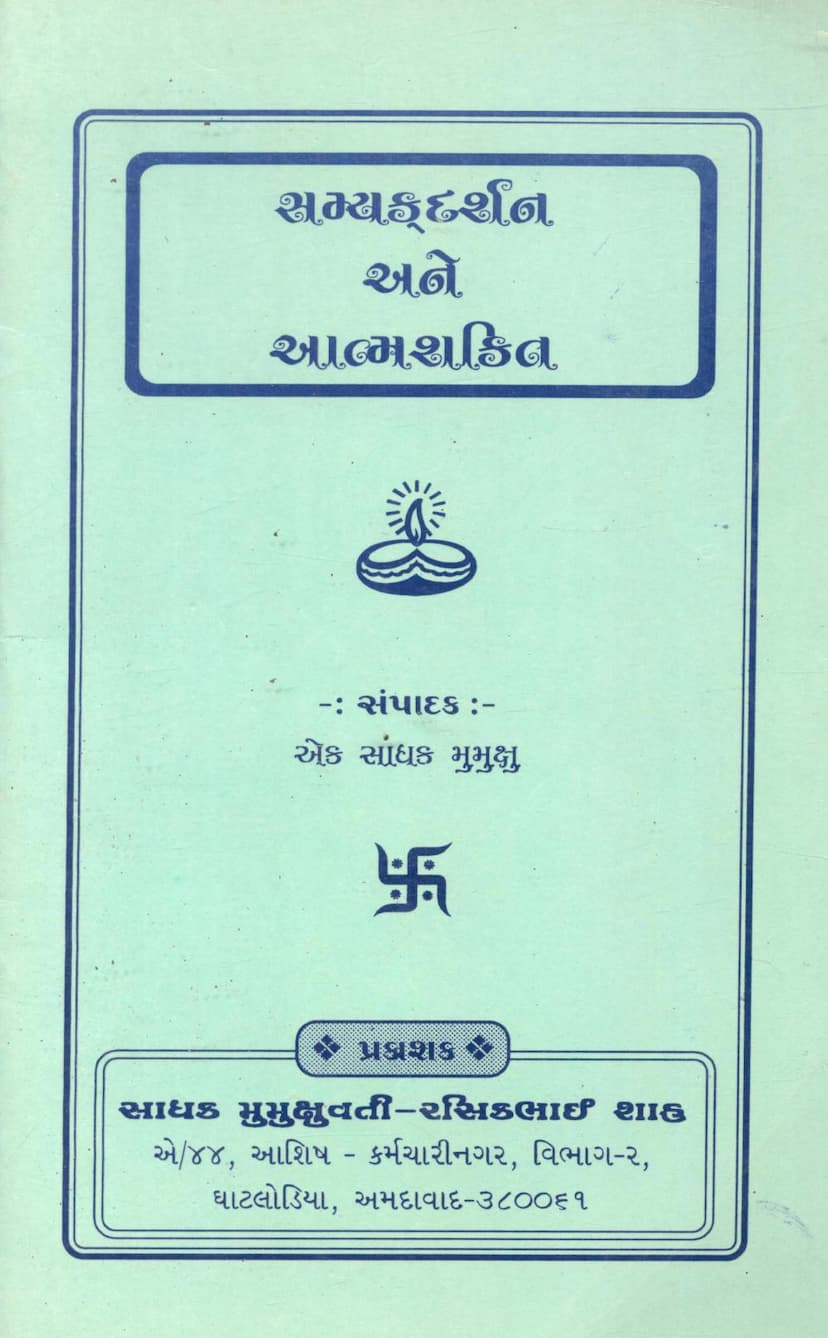Samyakdarshan Ane Aatmshakti
Added to library: September 2, 2025

Summary
Here's a comprehensive summary of the Jain text "Samyakdarshan ane Aatmashakti" based on the provided pages:
Book Title: Samyakdarshan ane Aatmashakti Author: Mumukshu (edited by Ek Sadhak) Publisher: Rasikbhai Shah
This book, "Samyakdarshan ane Aatmashakti" (Right Perception and Inner Strength), is a collection of spiritual insights and teachings, primarily focused on the path to self-realization and liberation within the Jain tradition. The text delves into the essence of true spiritual practice, emphasizing the attainment of Samyakdarshan (Right Perception) and the realization of one's inherent spiritual power (Aatmashakti).
Core Themes and Content:
The book is structured around key Jain philosophical concepts and practical guidance for spiritual seekers. It draws from the teachings of revered Jain saints and scholars like Pandit Todarmalji and Pandit Banarasidasji.
1. The Nature of Sadhana (Spiritual Practice):
- Moun (Silence): Highlighted as a primary weapon and essential tool for introspection and turning inward.
- Self-Awareness: Emphasizes understanding one's true state during sadhana for maximum benefit.
- Continuous Practice: True Aatmalakshi Sadhana (self-focused practice) is not limited to specific hours but is an all-day, all-night endeavor.
- Vairagya (Detachment) and Upsham (Equanimity): Their growth leads to Vivek (discretion) and Yathaarth (truthfulness), making spiritual progress easier.
- Faith and Dedication: The need for continuous increase in faith, devotion, and uniqueness towards the giver of sadhana, and the sadhana itself.
- Inner Qualities: Cultivating broadness of heart, control over senses, simplicity, and equanimity are crucial for sadhana.
- Inner Cultivation: Spiritual virtues are not external adornments but are to be nurtured, preserved, and lived from the heart.
- The Power of Intention and Speech: The inner self and the tongue are the best and worst aspects of a person. Benevolence within and truthfulness in speech are paramount. Misuse leads to lust and falsehood.
- Self-Reliance vs. Independence: A sadhak must be self-reliant but not licentious.
- Avoiding Deviation: A sadhak must remain vigilant against being misled in movement, thought, or disposition.
2. The Importance of Samyakdarshan (Right Perception):
- Correct Understanding: This section, particularly drawing from Pandit Todarmalji's letter, explains that Samyakdarshan is the correct understanding of self and non-self (Swa-Para Shradhhan).
- Overcoming Mithyatva (False Belief): It describes Mithyatva as the erroneous belief that the body is the self and identifying with it. This false understanding leads to endless cycles of birth and death.
- The Role of Darshan Mohaniya Karma: The subsidence, destruction, or partial destruction of Darshan Mohaniya Karma leads to Tattvarth Shradhhan (faith in true principles), resulting in Samyaktvi (one who has attained Right Perception).
- Shuddhatma Shradhhan: True Right Perception involves firm faith in the pure soul (Shuddhatma).
- Distinction from Ritualism: Merely adhering to Jain principles (Deva, Guru, Dharma, Seven Tattvas) without true self-knowledge and correct faith doesn't constitute Samyakdarshan. It requires distinguishing between the self and the non-self.
- The Transformative Power of Samyakdarshan: Upon attaining Samyakdarshan, previously erroneous knowledge (Kumati, Kushrut) transforms into right knowledge (Sumati, Sushrut). Whatever a Samyakdarshi knows is considered right knowledge, a part of omniscience.
- The Incalculable Glory of Samyakdarshan: Even a moment of self-experience can break more karmas than countless other efforts. It opens the door to liberation.
3. The Nature of Self-Experience (Sva-anubhav):
- Sva-anubhav as the Goal: The text stresses that Sva-anubhav (self-experience) is the ultimate goal and the key to liberation.
- Pratyaksha vs. Paroksha: The discussion delves into the nature of direct (Pratyaksha) and indirect (Paroksha) knowledge, particularly in relation to Samyakdarshan. While the ultimate experience of the soul is Pratyaksha, the path involves elements of Paroksha knowledge.
- Savikalpa and Nirvikalpa States: It describes the gradual progression from Savikalpa (conceptualized) states to Nirvikalpa (non-conceptualized) states of experience, where the meditator merges with the self.
- The Transition to Kevalgyan: Samyakdarshan is the seed for Kevalgyan (omniscience). As this Samyakgyan develops, it leads towards omniscience.
- The Incomparable Bliss: The Nirvikalpa experience leads to an unparalleled, indescribable bliss that surpasses all worldly pleasures.
4. Principles of Upadan and Nimitta (Material and Instrumental Causes):
- Upadan: The inherent, natural power or essence of a substance.
- Nimitta: External factors or causes that facilitate the manifestation of the Upadan.
- Self-Reliance in Spirituality: True spiritual progress comes from within (Upadan), while external guidance like scriptures, saints, and dharma are Nimitta.
- The Fourfold Classification (Choubhangi): The text explores the interaction of Upadan and Nimitta through a four-part classification, considering both pure and impure aspects of knowledge (Gyan) and conduct (Charitra) as both Nimitta and Upadan. This helps understand different spiritual states and progress.
5. The Forty-Seven Powers of the Soul (Aatmashakti): The latter part of the book extensively details various inherent powers of the soul, illustrating the soul's true, unadulterated nature:
- Jivatva Shakti: The power of existence as a conscious being.
- Chitti Shakti: The power of pure consciousness.
- Darshan Shakti: The power of perception, the ability to see the essence of all things without attachment or aversion.
- Gyan Shakti: The power of knowledge, the ability to know all knowable substances in their specific forms.
- Shakti-guṇas: The soul possesses infinite powers and qualities, which are inherently pure and eternal.
- The Role of Purushartha: Realizing these powers requires introspection and focused effort.
- The Illusion of External Causes: The text emphasizes that the soul's true state is self-generated, not dependent on external factors.
- The Ultimate Goal: The culmination of experiencing these powers is the attainment of omniscience, omnipotence, and ultimate bliss.
Overall Message:
"Samyakdarshan ane Aatmashakti" serves as a guide for individuals seeking spiritual upliftment. It stresses the paramount importance of right perception, the continuous cultivation of inner virtues, and the gradual unfolding of one's inherent spiritual potential. The book encourages a deep study of scriptures, introspection, and unwavering faith in the soul's true nature to achieve liberation. It provides a profound philosophical framework and practical steps for the journey towards spiritual perfection.